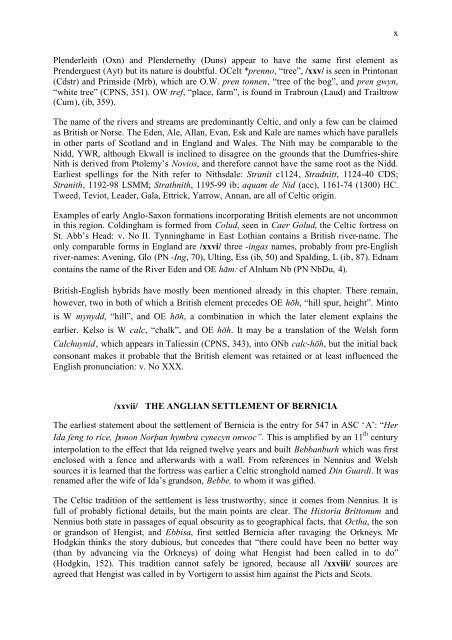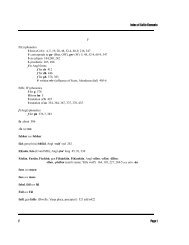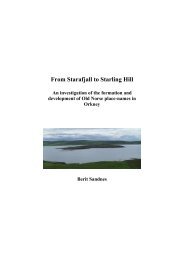May Williamson: The Non-Celtic Place-Names of the Scottish Border ...
May Williamson: The Non-Celtic Place-Names of the Scottish Border ...
May Williamson: The Non-Celtic Place-Names of the Scottish Border ...
Create successful ePaper yourself
Turn your PDF publications into a flip-book with our unique Google optimized e-Paper software.
x<br />
Plenderleith (Oxn) and Plendernethy (Duns) appear to have <strong>the</strong> same first element as<br />
Prenderguest (Ayt) but its nature is doubtful. OCelt *prenno, “tree”, /xxv/ is seen in Printonan<br />
(Cdstr) and Primside (Mrb), which are O.W. pren tonnen, “tree <strong>of</strong> <strong>the</strong> bog”, and pren gwyn,<br />
“white tree” (CPNS, 351). OW tref, “place, farm”, is found in Trabroun (Laud) and Trailtrow<br />
(Cum), (ib, 359).<br />
<strong>The</strong> name <strong>of</strong> <strong>the</strong> rivers and streams are predominantly <strong>Celtic</strong>, and only a few can be claimed<br />
as British or Norse. <strong>The</strong> Eden, Ale, Allan, Evan, Esk and Kale are names which have parallels<br />
in o<strong>the</strong>r parts <strong>of</strong> Scotland and in England and Wales. <strong>The</strong> Nith may be comparable to <strong>the</strong><br />
Nidd, YWR, although Ekwall is inclined to disagree on <strong>the</strong> grounds that <strong>the</strong> Dumfries-shire<br />
Nith is derived from Ptolemy’s Novios, and <strong>the</strong>refore cannot have <strong>the</strong> same root as <strong>the</strong> Nidd.<br />
Earliest spellings for <strong>the</strong> Nith refer to Nithsdale: Stranit c1124, Stradnitt, 1124-40 CDS;<br />
Stranith, 1192-98 LSMM; Strathnith, 1195-99 ib; aquam de Nid (acc), 1161-74 (1300) HC.<br />
Tweed, Teviot, Leader, Gala, Ettrick, Yarrow, Annan, are all <strong>of</strong> <strong>Celtic</strong> origin.<br />
Examples <strong>of</strong> early Anglo-Saxon formations incorporating British elements are not uncommon<br />
in this region. Coldingham is formed from Colud, seen in Caer Golud, <strong>the</strong> <strong>Celtic</strong> fortress on<br />
St. Abb’s Head: v. No II. Tynninghame in East Lothian contains a British river-name. <strong>The</strong><br />
only comparable forms in England are /xxvi/ three -ingas names, probably from pre-English<br />
river-names: Avening, Glo (PN -Ing, 70), Ulting, Ess (ib, 50) and Spalding, L (ib, 87). Ednam<br />
contains <strong>the</strong> name <strong>of</strong> <strong>the</strong> River Eden and OE hm: cf Alnham Nb (PN NbDu, 4).<br />
British-English hybrids have mostly been mentioned already in this chapter. <strong>The</strong>re remain,<br />
however, two in both <strong>of</strong> which a British element precedes OE hh, “hill spur, height”. Minto<br />
is W mynydd, “hill”, and OE hh, a combination in which <strong>the</strong> later element explains <strong>the</strong><br />
earlier. Kelso is W calc, “chalk”, and OE hh. It may be a translation <strong>of</strong> <strong>the</strong> Welsh form<br />
Calchuynid, which appears in Taliessin (CPNS, 343), into ONb calc-hh, but <strong>the</strong> initial back<br />
consonant makes it probable that <strong>the</strong> British element was retained or at least influenced <strong>the</strong><br />
English pronunciation: v. No XXX.<br />
/xxvii/<br />
THE ANGLIAN SETTLEMENT OF BERNICIA<br />
<strong>The</strong> earliest statement about <strong>the</strong> settlement <strong>of</strong> Bernicia is <strong>the</strong> entry for 547 in ASC ‘A’: “Her<br />
Ida feng to rice, onon Norþan hymbra cynecyn onwoc”. This is amplified by an 11 th century<br />
interpolation to <strong>the</strong> effect that Ida reigned twelve years and built Bebbanburh which was first<br />
enclosed with a fence and afterwards with a wall. From references in Nennius and Welsh<br />
sources it is learned that <strong>the</strong> fortress was earlier a <strong>Celtic</strong> stronghold named Din Guardi. It was<br />
renamed after <strong>the</strong> wife <strong>of</strong> Ida’s grandson, Bebbe, to whom it was gifted.<br />
<strong>The</strong> <strong>Celtic</strong> tradition <strong>of</strong> <strong>the</strong> settlement is less trustworthy, since it comes from Nennius. It is<br />
full <strong>of</strong> probably fictional details, but <strong>the</strong> main points are clear. <strong>The</strong> Historia Brittonum and<br />
Nennius both state in passages <strong>of</strong> equal obscurity as to geographical facts, that Octha, <strong>the</strong> son<br />
or grandson <strong>of</strong> Hengist, and Ebbisa, first settled Bernicia after ravaging <strong>the</strong> Orkneys. Mr<br />
Hodgkin thinks <strong>the</strong> story dubious, but concedes that “<strong>the</strong>re could have been no better way<br />
(than by advancing via <strong>the</strong> Orkneys) <strong>of</strong> doing what Hengist had been called in to do”<br />
(Hodgkin, 152). This tradition cannot safely be ignored, because all /xxviii/ sources are<br />
agreed that Hengist was called in by Vortigern to assist him against <strong>the</strong> Picts and Scots.




